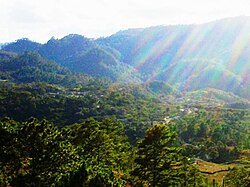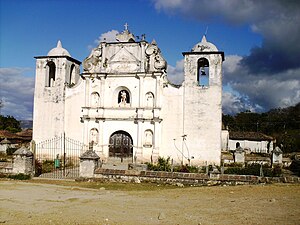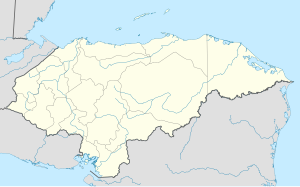San Sebastián, Lempira: Difference between revisions
I did what I could to salvage this article, but there are many issues. |
m Dating maintenance tags: {{Confusing section}} {{Tone}} |
||
| Line 1: | Line 1: | ||
{{EngvarB|date=July 2016}} |
{{EngvarB|date=July 2016}} |
||
{{Use dmy dates|date=July 2016}} |
{{Use dmy dates|date=July 2016}} |
||
{{other uses|San Sebastián}}{{Tone}}{{Infobox settlement |
{{other uses|San Sebastián}}{{Tone|date=April 2019}}{{Infobox settlement |
||
|official_name = San Sebastián |
|official_name = San Sebastián |
||
|native_name = Colosuca <!-- for cities whose native name is not in English --> |
|native_name = Colosuca <!-- for cities whose native name is not in English --> |
||
| Line 84: | Line 84: | ||
== Geography == |
== Geography == |
||
{{Confusing section}} |
{{Confusing section|date=April 2019}} |
||
{{Citation needed span|text=The municipality capital is up on a big mountain, surrounded by many pine trees and some oak trees. The mountains are very high and steep. In some of these mountains the vegetation changes to bushes and undergrowth. The origin of the rocks and soil all around is volcanic.|date=April 2019|reason=}} |
{{Citation needed span|text=The municipality capital is up on a big mountain, surrounded by many pine trees and some oak trees. The mountains are very high and steep. In some of these mountains the vegetation changes to bushes and undergrowth. The origin of the rocks and soil all around is volcanic.|date=April 2019|reason=}} |
||
| Line 99: | Line 99: | ||
== Population == |
== Population == |
||
{{Confusing section}} |
{{Confusing section|date=April 2019}} |
||
[[Indigenous peoples of Honduras|Indigenous Hondurans]] are only 60% of the population; the remaining 40% is [[Mestizo#Central America|Mestizo]]. |
[[Indigenous peoples of Honduras|Indigenous Hondurans]] are only 60% of the population; the remaining 40% is [[Mestizo#Central America|Mestizo]]. |
||
Revision as of 17:33, 2 April 2019
This article's tone or style may not reflect the encyclopedic tone used on Wikipedia. (April 2019) |
San Sebastián
Colosuca | |
|---|---|
Municipality | |
 Panoramic View San Sebastián | |
| Coordinates: 14°15′N 88°30′W / 14.250°N 88.500°W | |
| Country | Honduras |
| Department | Lempira |
| Municipality since | 7 March 1896 |
| Area | |
• Total | 227 km2 (88 sq mi) |
| Population (2014) | |
• Total | 10,857 |
| • Density | 48/km2 (120/sq mi) |
San Sebastian is a municipality in the Honduran department of Lempira.
It is one of the most isolated municipalities of the Lempira department. It is 13 km ahead of San Manuel Colohete. It is highly recommended[by whom?] to go on a 4-wheel drive vehicle when visiting this municipality.
History
In the census of 1887 it appears as Colosuca village, of Gracias. It became a municipality on 7 March 1896. The name "Colosuca" means "Beautiful Place"[whose translation?].

Geography
This section may be confusing or unclear to readers. (April 2019) |
The municipality capital is up on a big mountain, surrounded by many pine trees and some oak trees. The mountains are very high and steep. In some of these mountains the vegetation changes to bushes and undergrowth. The origin of the rocks and soil all around is volcanic.[citation needed]
Boundaries
Its boundaries are:
- North : San Manuel Colohete municipality and Ocotepeque department.
- South : Tomalá and San Andrés municipalities.
- East : La Campa and San Manuel Colohete municipalities.
- West : Guarita, Cololaca and San Marcos de Caiquin municipalities.
- Surface Extents: 227 km²
Resources
The coffee harvest provides a lot of jobs for the locals and even people from other places because it is the main economical activity of this region. The second most important activity is raising cattle. The commerce of groceries with Gracias is a very profitable activity. The corn and beans crops are mostly for local consumption. In 2007, they[who?] were installing the pipes for the sewer system. They obtained the water from perforated wells. Also, it[clarification needed] has electricity and mobile communications coverage. As for the transportation services, only one bus is available and it stays in the municipality capital and travels back from Gracias in the afternoon.
Population
This section may be confusing or unclear to readers. (April 2019) |
Indigenous Hondurans are only 60% of the population; the remaining 40% is Mestizo.
- Population:For the year 2001 this municipality had 8,025 people, this figure was the base for an estimate, resulting in 10,857 people for the year of 2015.
- Villages: 7
- Settlements: 108
Tourism
Once Colohete is passed the road becomes narrower and steeper and therefore more dangerous. There is 1 river to cross, in the rainy season it is just not possible to do so. There is also a 2nd river, but in this case a bridge was built. The "congolon" mountain can be seen to the south and some other mountains in Ocotepeque to the north. The old church also gives a good reason to visit, if the traveler enjoys ancient colonial buildings. This municipality is in the "Colosuca" path, this is organised by the national institute of tourism and some Mayor's offices of several municipalities. The object of this is to show the Indian legacy.
- Local Holidays: "San Sebastián" day on 20 January.
External links



